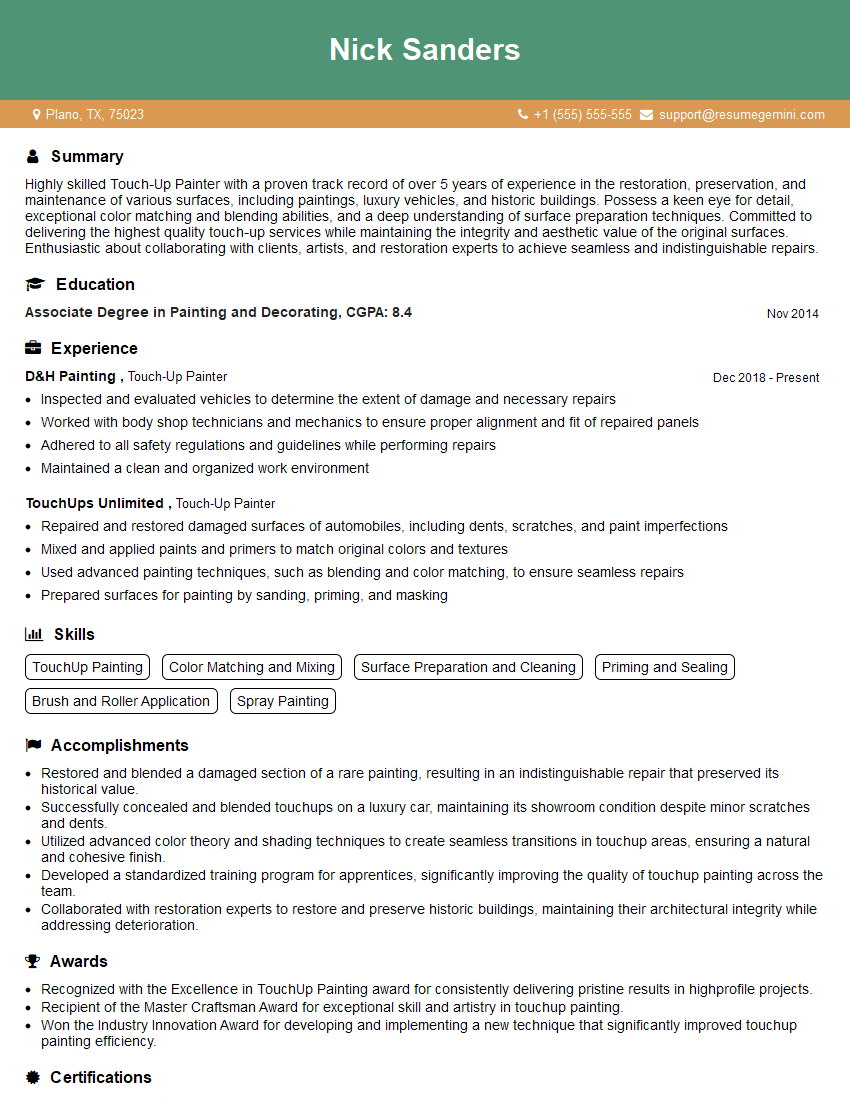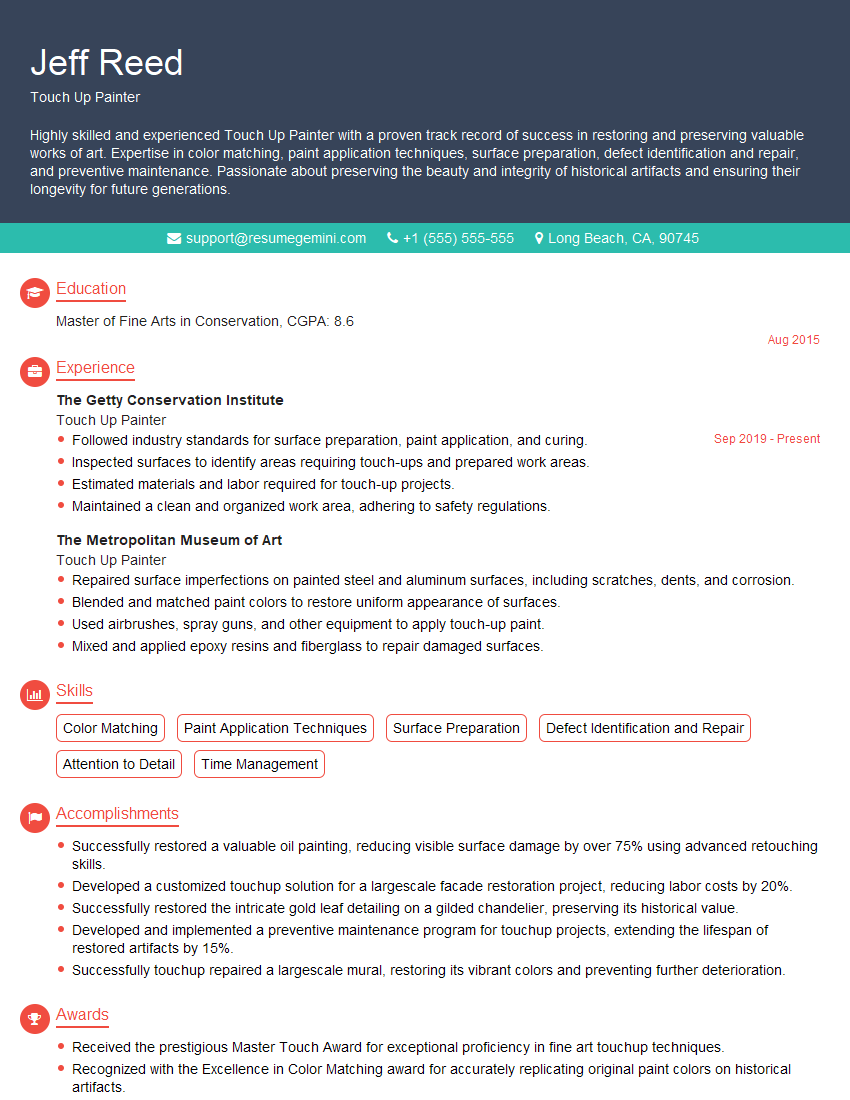Are you gearing up for a career shift or aiming to ace your next interview? Look no further! We’ve curated a comprehensive guide to help you crack the interview for the coveted Touch-Up Painter position. From understanding the key responsibilities to mastering the most commonly asked questions, this blog has you covered. So, buckle up and let’s embark on this journey together
Acing the interview is crucial, but landing one requires a compelling resume that gets you noticed. Crafting a professional document that highlights your skills and experience is the first step toward interview success. ResumeGemini can help you build a standout resume that gets you called in for that dream job.
Essential Interview Questions For Touch-Up Painter
1. What are the different types of touch-up painting techniques?
There are various touch-up painting techniques, including:
- Stippling: Using a small brush to create tiny dots of paint to blend with the existing finish.
- Feathering: Gradually blending the edges of the touch-up area with the surrounding paint.
- Glazing: Applying thin layers of transparent or semi-transparent paint to create depth and color.
- Trompe-l’oeil painting: Creating the illusion of depth and texture.
2. How do you determine the best paint match for a touch-up job?
Color Matching
- Examine the existing paint under natural and artificial light.
- Use a color matching system or consult with a paint expert.
- Test the color match on a small, inconspicuous area before proceeding.
Sheen Matching
- Identify the sheen of the existing finish (flat, satin, semi-gloss, gloss).
- Match the sheen of the touch-up paint to maintain a uniform appearance.
3. What are the steps involved in preparing a surface for touch-up painting?
- Clean the surface to remove dirt, dust, and grease.
- Sand the area to smooth out any imperfections.
- Prime the surface to create a bonding surface for the paint.
- Mask off surrounding areas to protect them from overspray.
4. How do you handle touch-ups on different types of surfaces (e.g., wood, metal, plastic)?
- Wood: Sand, prime, and use a compatible paint that is formulated for wood.
- Metal: Clean with a metal cleaner, sand, and use a paint specifically designed for metal surfaces.
- Plastic: Use a plastic adhesion promoter or primer, sand, and apply a paint that is flexible enough for plastic.
5. What are the common challenges you face during touch-up painting and how do you overcome them?
- Color mismatch: Use accurate color matching techniques and experiment with blending to achieve a seamless transition.
- Uneven texture: Prepare the surface thoroughly, use appropriate sanding techniques, and feather the edges of the touch-up area.
- Visible brushstrokes: Use a fine-tipped brush, apply thin layers of paint, and blend the edges carefully.
- Overspray: Mask off surrounding areas meticulously and use a light touch when spraying.
6. How do you ensure the longevity of your touch-up repairs?
- Proper surface preparation and priming.
- Using high-quality paint that is compatible with the surface.
- Applying multiple thin coats instead of one thick coat.
- Allowing ample drying time between coats.
- Protecting the touch-up area from moisture and wear.
7. What safety precautions do you take when touch-up painting?
- Wear appropriate safety gear (respirator, gloves, eye protection).
- Ventilate the work area properly.
- Handle and dispose of paint and solvents safely.
- Use ladders and scaffolding securely.
8. How do you stay up-to-date with advancements in touch-up painting techniques and materials?
- Attend industry workshops and conferences.
- Read trade magazines and online resources.
- Consult with paint manufacturers and suppliers.
- Engage in continuous learning and experimentation.
9. What is your approach to working with different clients and managing their expectations?
- Establish clear communication channels.
- Understand their needs and expectations thoroughly.
- Provide regular updates and seek feedback.
- Address concerns promptly and professionally.
- Aim to exceed their expectations while adhering to the agreed-upon scope of work.
10. Can you describe a particularly challenging touch-up painting project you completed?
Provide a detailed account of the project, highlighting the challenges encountered, the techniques employed, and the successful outcome.
Interviewers often ask about specific skills and experiences. With ResumeGemini‘s customizable templates, you can tailor your resume to showcase the skills most relevant to the position, making a powerful first impression. Also check out Resume Template specially tailored for Touch-Up Painter.
Career Expert Tips:
- Ace those interviews! Prepare effectively by reviewing the Top 50 Most Common Interview Questions on ResumeGemini.
- Navigate your job search with confidence! Explore a wide range of Career Tips on ResumeGemini. Learn about common challenges and recommendations to overcome them.
- Craft the perfect resume! Master the Art of Resume Writing with ResumeGemini’s guide. Showcase your unique qualifications and achievements effectively.
- Great Savings With New Year Deals and Discounts! In 2025, boost your job search and build your dream resume with ResumeGemini’s ATS optimized templates.
Researching the company and tailoring your answers is essential. Once you have a clear understanding of the Touch-Up Painter‘s requirements, you can use ResumeGemini to adjust your resume to perfectly match the job description.
Key Job Responsibilities
Touch-Up Painters perform a crucial role in maintaining the aesthetics and quality of various surfaces. Their responsibilities include:
1. Touching Up and Repairing Surfaces
Touch-Up Painters identify and repair minor imperfections, scratches, dents, or discolouration on surfaces.
- Inspect surfaces for damaged or faded areas.
- Mix and apply appropriate paints or coatings to restore the original appearance.
2. Preparing Surfaces
To ensure proper paint adhesion and a smooth finish, they meticulously prepare surfaces.
- Clean and degrease surfaces to remove dirt, oil, or other contaminants.
- Sand or scrape surfaces to create a smooth base.
- Apply primers or sealers to enhance paint adhesion and prevent stains.
3. Painting and Finishing
Touch-Up Painters skillfully apply paints and coatings to surfaces, achieving a flawless finish.
- Choose and mix appropriate paint colours and textures.
- Apply paints using brushes, rollers, or spray equipment.
- Sand and polish surfaces to achieve desired smoothness and gloss.
4. Colour Matching
Matching existing colours is essential for seamless repairs.
- Use colour charts and mixing techniques to replicate original paint colours.
- Experiment with different paint formulations to achieve accurate colour matches.
Interview Tips
Preparing for a Touch-Up Painter interview requires a combination of technical knowledge and interpersonal skills.
1. Highlight Your Attention to Detail
Emphasize your meticulous nature and exceptional attention to detail. Describe experiences where you identified and corrected even subtle surface imperfections.
- Example Outline: “In my previous role, I meticulously inspected surfaces for even the smallest scratches, chips, or discolouration. My keen eye allowed me to identify and repair these imperfections, resulting in flawless finishes.”
2. Showcase Your Painting Expertise
Demonstrate your proficiency in various painting techniques, including colour matching, preparation, and application. Provide specific examples of your successful touch-up or repair projects.
- Example Outline: “I have extensive experience in colour matching, using both visual observation and colour charts to replicate existing paint colours. In my last project, I successfully matched a complex multi-hue paint scheme, ensuring a seamless repair that was indistinguishable from the original surface.”
3. Emphasize Your Commitment to Quality
Stress your commitment to delivering high-quality results, adhering to industry standards and customer expectations. Highlight your understanding of surface preparation techniques and the importance of proper paint application for long-lasting results.
- Example Outline: “I am committed to exceeding customer expectations by delivering exceptional touch-up and repainting services. I adhere strictly to industry best practices, ensuring that surfaces are properly prepared and painted to achieve durable, aesthetically pleasing results.”
4. Demonstrate Your Communication Skills
Effective communication is crucial for understanding customer needs and ensuring project satisfaction. Describe your ability to interact professionally with clients and colleagues, clarifying requirements and providing regular updates.
- Example Outline: “I possess strong communication skills, enabling me to clearly understand client requirements and explain technical concepts in a straightforward manner. I am comfortable working independently and as part of a team, actively seeking feedback to ensure project success.”
Next Step:
Armed with this knowledge, you’re now well-equipped to tackle the Touch-Up Painter interview with confidence. Remember, a well-crafted resume is your first impression. Take the time to tailor your resume to highlight your relevant skills and experiences. And don’t forget to practice your answers to common interview questions. With a little preparation, you’ll be on your way to landing your dream job. So what are you waiting for? Start building your resume and start applying! Build an amazing resume with ResumeGemini.

